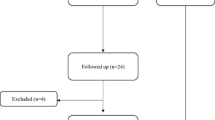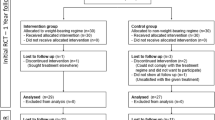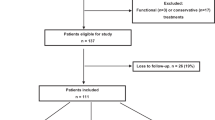Abstract
Purpose
The ideal treatment for Achilles tendon ruptures is still unknown. Biomechanical were correlated to radiological and clinical parameters to study outcomes.
Methods
In this retrospective, assessor-blinded multi-centre cohort study, 52 patients with unilateral Achilles tendon rupture were assessed, each at least 3 years after injury. Patients underwent open surgery, percutaneous surgery or non-surgical treatment of Achilles tendon rupture. Both legs underwent plantar pressure distribution and isokinetic measures. Demographic parameters, maximum calf circumference (MCC) and clinical scores (American Orthopaedic Foot and Ankle Society, Achilles tendon rupture score, Hannover) were also evaluated. Complications were not assessed.
Results
Peak plantar flexion torque (PPFT) was significantly weaker on the treated side compared to the untreated leg [80.4 ± 29.7 Nm (mean ± SD) vs. 92.1 ± 27.4 Nm, p < 0.0001]. PPFT and push-off force (POFF) were not different between treatment groups nor was there a leg difference in POFF alone. There was only a weak correlation of clinical scores and PPFT or POFF, respectively. MCC correlated significantly with both PPFT (R 2 = 0.21, p = 0.01) and POFF (R 2 = 0.29, p < 0.0001). POFF appeared to be a predictor of PPFT (R 2 = 0.31, p < 0.0001). Open surgery outperformed non-surgical treatment in terms of centre-of-pressure line (p = 0.007), torque per muscle volume (p = 0.04) and relative POFF per body weight (p = 0.02) and relative in side comparison (p = 0.03).
Conclusions
Clinical scores do not predict biomechanical outcomes. Clinically measured MCC is a good predictor of PPFT and POFF and can easily be used in clinical practice. Relative POFF in side comparison as well as per body weight favours surgical treatment.

Similar content being viewed by others
References
Atik OS, Bolukbasi S, Kanatli U (2011) Does surgical repair of acute Achilles tendon rupture cause structural changes on 15-year follow-up? Eklem Hastalik Cerrahisi 22(1):54–55
Carter TR, Fowler PJ, Blokker C (1992) Functional postoperative treatment of Achilles tendon repair. Am J Sports Med 20(4):459–462
Cetti R, Henriksen LO, Jacobsen KS (1994) A new treatment of ruptured Achilles tendons. A prospective randomized study. Clin Orthop Relat Res 308:155–165
Chan AP, Chan YY, Fong DT, Wong PY, Lam HY, Lo CK, Yung PS, Fung KY, Chan KM (2011) Clinical and biomechanical outcome of minimal invasive and open repair of the Achilles tendon. Sports Med Arthrosc Rehabil Ther Technol 3(1):32
Clarence L, Shields JR, Kerlan RK et al (1978) The Cybex II evaluation of surgically repaired Achilles tendon ruptures. Am J Sports Med 6(6):369–372
FitzGibbons RE, Hefferon J, Hill J (1993) Percutaneous Achilles tendon repair. Am J Sports Med 21(5):724–727
Gillies H, Chalmers J (1970) The management of fresh ruptures of the tendo Achillis. J Bone Joint Surg Am 52(2):337–343
Häggmark T, Liedberg H, Eriksson E, Wredmark T (1986) Calf muscle atrophy and muscle function after non-operative vs operative treatment of Achilles tendon ruptures. Orthopedics 9(2):160–164
Inglis AE, Scott WN, Sculco TP, Patterson AH (1976) Ruptures of the tendo Achillis. An objective assessment of surgical and non-surgical treatment. J Bone Joint Surg Am 58(7):990–993
Jacobs D, Martens M, Van Audekercke R, Mulier JC, Mulier F (1978) Comparison of conservative and operative treatment of Achilles tendon rupture. Am J Sports Med 6(3):107–111
Khan RJ, Carey Smith RL (2010) Surgical interventions for treating acute Achilles tendon ruptures. Cochrane Database Syst Rev (9):CD003674. doi:10.1002/14651858.CD003674.pub4
Khan RJ, Fick D, Keogh A, Crawford J, Brammar T, Parker M (2005) Treatment of acute Achilles tendon ruptures. A meta-analysis of randomized, controlled trials. J Bone Joint Surg Am 87(10):2202–2210
Kitaoka HB, Alexander IJ, Adelaar RS, Nunley JA, Myerson MS, Sanders M (1994) Clinical rating systems for the ankle-hindfoot, midfoot, hallux, and lesser toes. Foot Ankle Int 15(7):349–353
Klein P, Mattys S, Rooze M (1996) Moment arm length variations of selected muscles acting on talocrural and subtalar joints during movement: an in vitro study. J Biomech 29(1):21–30
Krapf D, Kaipel M, Majewski M (2012) Structural and biomechanical characteristics after early mobilization in an Achilles tendon rupture model: operative versus nonoperative treatment. Orthopedics 35(9):e1383–e1388
Lephart SM, Ferris CM, Riemann BL, Myers JB, Fu FH (2002) Gender differences in strength and lower extremity kinematics during landing. Clin Orthop Relat Res 401:162–169
Leppilahti J, Lähde S, Forsman K, Kangas J, Kauranen K, Orava S (2000) Relationship between calf muscle size and strength after Achilles rupture repair. Foot Ankle Int 21(4):330–335
Maganaris CN, Narici MV, Maffulli N (2008) Biomechanics of the Achilles tendon. Disabil Rehabil 30(20–22):1542–1547
Magnusson SP, Narici MV, Maganaris CN, Kjaer M (2008) Human tendon behaviour and adaptation, in vivo. J Physiol 586(1):71–81
Maughan RJ, Watson JS, Weir J (1984) Muscle strength and cross-sectional area in man: a comparison of strength-trained and untrained subjects. Br J Sports Med 18(3):149–157
McComis GP, Nawoczenski DA, DeHaven KE (1997) Functional bracing for rupture of the Achilles tendon. Clinical results and analysis of ground-reaction forces and temporal data. J Bone Joint Surg Am 79(12):1799–1808
Metz R, van der Heijden GJ, Verleisdonk EJ, Tamminga R, van der Werken C (2009) Recovery of calf muscle strength following acute Achilles tendon rupture treatment: a comparison between minimally invasive surgery and conservative treatment. Foot Ankle Spec 2(5):219–226
Mezzarobba S, Bortolato S, Giacomazzi A, Fancellu G, Marcovich R, Valentini R (2012) Percutaneous repair of Achilles tendon ruptures with Tenolig: quantitative analysis of postural control and gait pattern. Foot (Edinburgh, Scotland) 22(4):303–309
Möller M, Movin T, Granhed H, Lind K, Faxén E, Karlsson J (2001) Acute rupture of tendon Achillis. A prospective randomised study of comparison between surgical and non-surgical treatment. J Bone Joint Surg Br 83(6):843–848
Mortensen H, Skov O, Jensen P (1999) Early motion of the ankle after operative treatment of a rupture of the Achilles tendon. A prospective, randomized clinical and radiographic study. J Bone Joint Surg Am 81(7):983–990
Mullaney MJ, McHugh MP (2006) Concentric and eccentric muscle fatigue of the shoulder rotators. Int J Sports Med 27(9):725–729
Mullaney MJ, McHugh MP, Tyler TF, Nicholas SJ, Lee SJ (2006) Weakness in end-range plantar flexion after Achilles tendon repair. Am J Sports Med 34(7):1120–1125
Nilsson-Helander K, Thomee R, Silbernagel KG, Thomee P, Faxen E, Eriksson BI, Karlsson J (2007) The Achilles tendon total rupture score (ATRS): development and validation. Am J Sports Med 35(3):421–426
Olsson N, Nilsson-Helander K, Karlsson J, Eriksson BI, Thomee R, Faxen E, Silbernagel KG (2011) Major functional deficits persist 2 years after acute Achilles tendon rupture. Knee Surg Sports Traumatol Arthrosc 19(8):1385–1393
Olsson N, Silbernagel KG, Eriksson BI, Sansone M, Brorsson A, Nilsson-Helander K, Karlsson J (2013) Stable surgical repair with accelerated rehabilitation versus nonsurgical treatment for acute Achilles tendon ruptures: a randomized controlled study. Am J Sports Med. doi:10.1177/0363546513503282
Rebeccato A, Santini S, Salmaso G, Nogarin L (2001) Repair of the Achilles tendon rupture: a functional comparison of three surgical techniques. J Foot Ankle Surg 40(4):188–194
Rettig AC, Liotta FJ, Klootwyk TE, Porter DA, Mieling P (2005) Potential risk of rerupture in primary Achilles tendon repair in athletes younger than 30 years of age. Am J Sports Med 33(1):119–123
Rosso C, Schuetz P, Polzer C, Weisskopf L, Studler U, Valderrabano V (2012) Physiological Achilles tendon length and its relation to tibia length. Clin J Sport Med 22(6):483–487
Rosso C, Vavken P, Polzer C, Buckland DM, Studler U, Weisskopf L, Lottenbach M, Muller AM, Valderrabano V (2013) Long-term outcomes of muscle volume and Achilles tendon length after Achilles tendon ruptures. Knee Surg Sports Traumatol Arthrosc 21(6):1369–1377
Sadoghi P, Rosso C, Valderrabano V, Leithner A, Vavken P (2012) Initial Achilles tendon repair strength-synthesized biomechanical data from 196 cadaver repairs. Int Orthop 36(9):1947–1951
Shields CL Jr, Kerlan RK, Jobe FW, Carter VS, Lombardo SJ (1978) The Cybex II evaluation of surgically repaired Achilles tendon ruptures. Am J Sports Med 6(6):369–372
Speck M, Klaue K (1998) Early full weightbearing and functional treatment after surgical repair of acute Achilles tendon rupture. Am J Sports Med 26(6):789–793
Starkey DB, Pollock ML, Ishida Y, Welsch MA, Brechue WF, Graves JE, Feigenbaum MS (1996) Effect of resistance training volume on strength and muscle thickness. Med Sci Sports Exerc 28(10):1311–1320
Thermann H, Zwipp H, Tscherne H (1995) Functional treatment concept of acute rupture of the Achilles tendon. 2 years results of a prospective randomized study. Unfallchirurg 98(1):21–32
Washburn SD, Caiozzo VJ, Wills CA, Hunt BJ, Prietto CA (1992) Alterations in the in vivo torque-velocity relationship after Achilles tendon rupture. Further evidence of speed-specific impairment. Clin Orthop Relat Res 279:237–245
Willits K, Amendola A, Bryant D, Mohtadi NG, Giffin JR, Fowler P, Kean CO, Kirkley A (2010) Operative versus nonoperative treatment of acute Achilles tendon ruptures: a multicenter randomized trial using accelerated functional rehabilitation. J Bone Joint Surg Am 92(17):2767–2775
Acknowledgments
We thank Xavier Kaelin MSc and Marlene Mauch PhD for their biomechanical studies and their steady effort in patient examinations. From the Department of Radiology, we would like to thank Dr. Ueli Studler for his help in the radiologic workup and Tanja Haas for her MRI examinations. We thank Professor Beat Hintermann, Dr. Marc Lottenbach and Dr. Martin Majewski, for their contribution in patient acquisition. The lead centre of this study was the University Hospital Basel, Basel, Switzerland. This multi-centre study was funded by a grant from the Swiss National Accident Insurance Company (SUVA), Lucerne, Switzerland. DMB is funded by a post-doctoral fellowship from the Whitaker International Program.
Conflict of interest
Each author certifies that he or she has no commercial associations that might pose a conflict of interest in connection with the submitted article.
Author information
Authors and Affiliations
Corresponding author
Rights and permissions
About this article
Cite this article
Rosso, C., Buckland, D.M., Polzer, C. et al. Long-term biomechanical outcomes after Achilles tendon ruptures. Knee Surg Sports Traumatol Arthrosc 23, 890–898 (2015). https://doi.org/10.1007/s00167-013-2726-2
Received:
Accepted:
Published:
Issue Date:
DOI: https://doi.org/10.1007/s00167-013-2726-2




